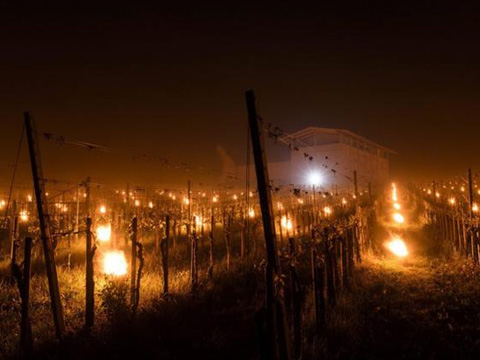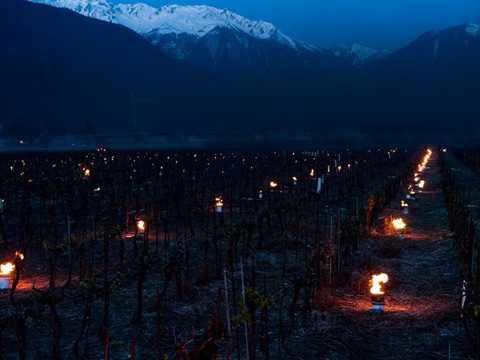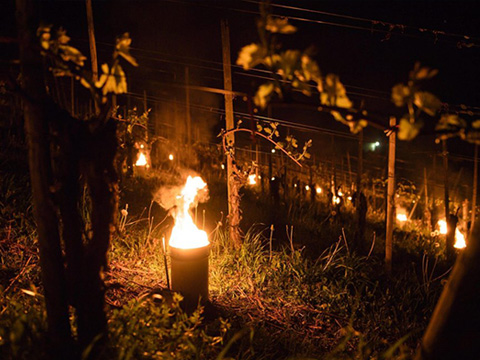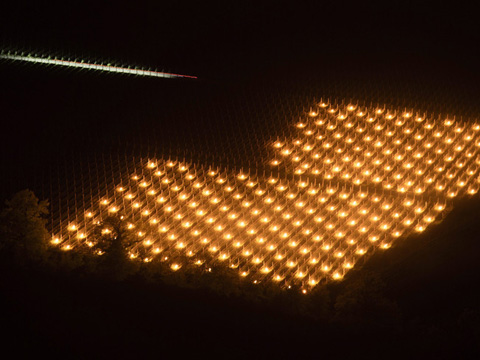Vineyard Frost Protection
Budbreak is one of the most exciting times of year for the backyard winegrower. The snow has melted and you can feel the warmth of the sun on your face. The smell of new grass and the perfume of crocuses, daffodils and hyacinth is in the air. The vineyard is pruned, trellis wires are tightened and a new vintage is underway. It’s a beautiful time of year filled with anticipation of a healthy new crop of grapes to make delicious new wine with. It’s a long road from budbreak to a harvest of perfectly ripened grapes though, a road that holds many perils along the way. Depending on your growing region and climate, a few of those obstacles may include hail, mildew, fungal diseases, insects, animals and even an overabundance of rain. Any of these threats has the potential to destroy or greatly reduce the quality of an otherwise healthy crop of high quality wine grapes. There is one threat, however that has the potential to destroy a crop of grapes before it even begins — the threat of frost.
Frost damage happens when temperatures drop below 32 °F (0 °C) after green growing tissue has appeared from a bud. It is generally a threat early in the growing season on cold clear nights, shortly after budbreak. It is such a danger because the first green growth produced on a new grapevine shoot is two or three basal leaves, immediately followed by the embryonic flower clusters that will become this year’s crop. So, if frost strikes, it can greatly reduce or even wipe out the whole vintage. Frost damage occurs in many growing regions throughout the United States, Canada, Europe and South America, to mention a few. Generally cool and cold climate growing regions are at greatest risk, but even warmer regions like California and Bordeaux can be affected in some years. If you grow grapes in a cool or cold climate, frost will likely be an annual problem for you. Since weather is the one thing a grower cannot control, frost can’t be prevented. There is however, much a grower can do to prevent or minimize frost damage. Let’s review some practical techniques that the backyard grape grower can employ to prevent frost damage in the vineyard. Before we get started, it’s worth noting that some techniques mentioned here might not be practical on a large scale in commercial vineyards. Conversely there is equipment used for frost protection in commercial vineyards that may not be affordable to the backyard grower. So this article will focus on solutions that are practical for home wine grape growers and winemakers.
Site Selection to Avoid Cold Spots
Those of us with established vineyards or limited space have little control over site selection. But if you are currently planning a vineyard, there are a few things to keep in mind about frost before you plant. Frost usually happens because of something called radiational cooling. This happens after those beautiful sunny days in early spring that we love so much. Brilliant blue skies and bright sun give way to very clear but downright cold nights. This is because with no cloud cover to trap the warm air of the day, it escapes very quickly into the atmosphere at night. By the time dawn rolls around, the temperatures have had a chance to flirt with freezing temperatures in the vineyard. This is where choosing where you plant your vines comes into play. If there are any hills or low-spots on your site, keep these in mind when laying out and planting your vines. Avoid low-spots, gullies and areas where cold air can become trapped. Remember that cold air falls and hot air rises. So if you plant at the bottom of a hill for example, you run a greater risk for frost damage. If possible, plant vines on the upper sides of hills or slopes where cold air can “drain” or flow down to lower locations. Keep in mind that if you are in a rural area and have a very high hill, it could affect the temperature negatively since temperatures drop at higher altitudes. This is generally not a problem in backyard vineyards with small hills or slopes, but take the time to get to know your site. Find any warm or cold spots and use them to your advantage.
Varietal Selection to Match Climate
Another consideration for avoiding frost damage is what varieties you will plant. This is another factor primarily for vineyards in the planning stage, or for growers who may want to consider removing one variety and replacing it with a more suitable one. All varieties have different growth characteristics and habits. The one that can affect the likelihood of frost damage most greatly, is the time of budbreak. Some vines begin their growth cycle much sooner than others. For example, in my vineyard Marechal Foch is the earliest variety to bud out, followed by another hybrid called Regent.
The actual date of budbreak will also vary from year to year depending on temperature. The average date of budbreak in my Upstate New York vineyard is the last week in April for my Foch and 7–10 days later for Riesling. These dates can vary by as much as a week or more if there is an early warm spell or late cold spell. A bud will begin to lose its resistance to cold temperatures as it starts to swell. A fully dormant bud has no problem with temperatures below 32 °F (0 °C). As the vine begins to come out of dormancy, the bud slowly begins to swell. The amount of cold it can safely handle will decrease as it moves closer to showing green tissue. Generally by the time any green growth is visible, temperatures below freezing will damage that green growth. So a variety with later budbreak will help you to avoid the periods of danger in your growing region. This point comes with a big disclaimer: you must plant varieties that will have time to ripen in your growing season. While Vitis vinifera varieties like Cabernet Sauvignon and Chardonnay may begin growing later, they also require a longer growing season to ripen properly. So when choosing varieties based upon the last frost dates in your area, make sure you consider when the first killing frost of the year usually occurs and pick a variety that will ripen well for making wine. One of the best ways to do this is to visit local commercial vineyards or local backyard growers and see what varieties they are growing successfully.
Delayed Pruning and Double Pruning
Now that we’ve discussed what can be done to avoid frost damage prior to planting, let’s talk about what those of us with established vineyards can do. One of the easiest and most practical ways to avoid frost damage in your vineyard is to use a grapevine’s natural growth habit to your advantage. This can be done by pruning techniques called delayed pruning and double pruning or a combination of both. These pruning techniques take advantage of a characteristic that all grapevines have called apical dominance. This term simply means that the buds on the tip of a cane will grow first and the buds at the base of a cane, closest to the trunk, will begin to grow last. The easiest way to use this to your advantage is to use delayed pruning. Delayed pruning simply means to delay the pruning of your grape vines in order to avoid frost damage. For example, many commercial vineyards do the bulk of their pruning in the winter months because they have so many vines to prune. During pruning, they may take a cane that has 30 or more buds and prune in down to 10 or less. When daily temperatures begin to edge up past 50–60 °F (10–16 °C) for a week or more, this begins to trigger bud swell. If the cane is pruned to 10 buds, the buds out on the end will begin to swell first and grow. If green tissue appears and then a frost event happens, those buds can be damaged, affecting this year’s crop.
However, if that same cane is left at 30 buds, there are twenty buds that will want to break first. That way if a frost event happens, the damage will occur to buds that are going to be pruned off anyway. When the likelihood of frost decreases, those excess buds can be pruned, leaving the 10 healthy buds that will produce this year’s crop. It’s that simple.
There are a few things to keep in mind, though. First of all, pruning after bud swell requires extra care. From bud swell on through the time the shoots reach 12” (30 cm) or so, they can be easily broken off. Take care not to break off or damage the buds that you will be keeping. This will also slow you down considerably when you prune, which can be a problem if you have more than just a few vines.
If you have enough established vines that delayed pruning is impractical, double pruning may come in handy for you. Double pruning involves pruning in two stages, a rough pruning in the colder months when the vine is completely dormant and a final pruning just after budbreak. This method can work well if you have more than 10 vines to prune because you still get the bulk of your work done while the vines are dormant. That enables you to work faster because you don’t have to worry as much about breaking buds off.
When double pruning, you just prune off all excess canes, with the exception of the ones you will be using for fruiting wood this year. Do not shorten the length of the canes you choose to keep. Position them as close as possible to where they will be tied and tie them loosely to the trellis wires if you can. The buds furthest out on these canes will swell and break first. When the frost threat diminishes, cut them to length and secure them firmly to the trellis wires. Double pruning will not delay budbreak as long as delayed pruning will, but is an excellent compromise if you have a lot of pruning to do. It’s interesting to note that studies have shown that these techniques do not delay harvest dates. Grapes from late buds and early buds have been shown to ripen at nearly the same time. That has been true in my vineyard as well. If you have a cold or cool climate vineyard, I highly recommend using these pruning techniques every year.
Frost Protection
OK, so you’ve chosen the right varieties, picked the best site, employ delayed pruning and there’s a late frost being predicted tonight. Now what do you do? It’s true that sometimes, despite your best efforts, a late frost will come and threaten the beautiful baby green leaves and flower clusters that are growing so nicely on your vines. This is when frost intervention is the only option. It’s you waging war against the weather to protect your babies. In commercial vineyards in France, growers will line the vineyard rows with 55-gallon (~210-L) drums and start light against frost candles in them. They stay out all night tending the fires to keep the cold air from settling down on the vineyard. It works good. Depending on where you live, it may be an option for your vineyard.
So far it has worked for me every time I have done it in the past 8 years. A few things to keep in mind about this, do not wait until the day you need frost protection to get set up. If spring frosts are a possibility in your vineyard, get the anti frost candles in time.
We receive enquiries in English, Español (Spanish), Русский язык (Russian), Français (French) and العربية (Arabic). Our professional team will reply to you within one business day. Please feel FREE to contact us!

.jpg)




